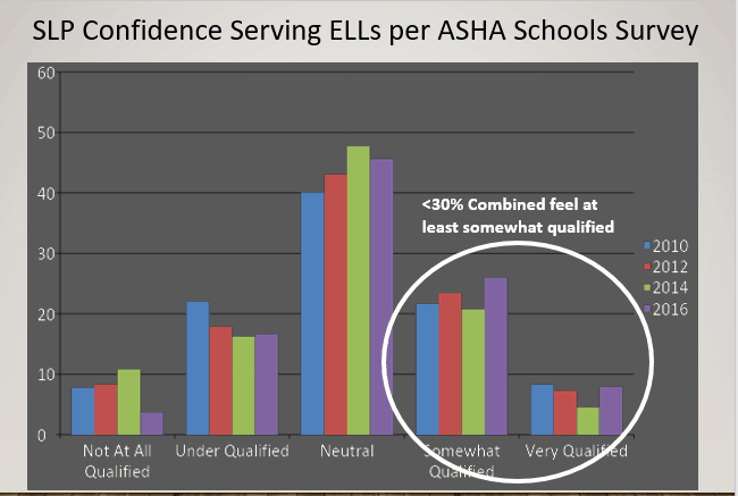Cultural Parameters and SLPs: Speech language pathologists self report that they do not feel confident serving English language learners. In this data taken from the ASHA schools survey, we see that the trend is continual across the last half decade. Moreover, less than 30% of us feel confident serving diverse caseloads.

Across the nation, English language learners make up at least 20% of our caseloads. In states along the coasts and in the southern United States that percentage is much higher.

ASHA reports that clients from culturally and linguistically diverse backgrounds comprise almost 35% of speech-language pathologists’ caseloads across employment settings (ASHA survey, 2012). Given these demographics:
Effectively accounting for the influence of culture enables us to distinguish between the children who are simply making the errors that are normal when learning a second language and the children who have speech and language impairments.
Cultural Parameters and You

We all have a basic understanding of what culture is. However, to truly understand culture and see how it is affecting the work we do, we need an easy way to break culture down into its building blocks so that we can broaden our understanding. The nuts and bolts of it is that you think and feel a certain way based on your culture. Yes, you. Me. Everyone. We may not even think about cultural differences until we are presented with an alternative.
I remember the first time I went home with my roommate and spent the holidays with his family. I grew up with a lot of sisters and a mother who had a pretty big rule book. He grew up with a lot of brothers. On Christmas morning, my roommate’s 19-year-old brother came into the kitchen and announced he was going to eat “now!” His mother said he would have to wait. He proceeded to wrestle his mother to the floor, fighting for the spatula while she hit him with it and laughed hysterically! I was aghast. I told my mom about it and she said “You just try it next time you’re home.”
The point is that culture dictates how we interact and there are many ways of going about it. No way is wrong, just different. This is all fine and interesting, as long as we are not diagnosing a disorder based on these “differences.” Luckily, some research conducted by Brislin (1994) and Tomoeda & Bayles (2002) gives us a way to view cultural parameters through different lenses: the value placed on individualism versus collectivism, views of time and space, roles of men and women, concepts of class and status, values, language, rituals, the significance of work, and beliefs about health.
Application of Cultural Parameters to the Assessment of Speech and Language Disorders
Regardless of culture, the assessment of a disorder usually follows a similar pattern, with the client and his or her environment assessed relative to: (a) identifying a potentially clinically significant problem that would persist without intervention; (b) understanding and describing the nature of the problem in a variety of communicative contexts considering the influence of physiological, socio-cultural, and linguistic variables; (c) determining the severity of the problem and the level of impact it has on the client’s adjustments to life (e.g. personal, social, educational, occupational); and (d) developing an appropriate course of action for intervention (Finn & Cordes, 1997; Watson & Kayser, 1994).
Application of Cultural Parameters to the Assessment of Speech and Language Disorders
ASHA’s position on the importance of culture is based on the assumption that clients’ cultural beliefs will influence how they describe their health problems, the manner in which they communicate their symptoms, who they seek for health care, how long they remain in care, and how they assess the care provided. Culturally familiar environments facilitate success in treatment as clients are more secure and responsive in these settings. If clients feel the security of a culturally familiar environment, these clients may be more likely to respond freely and may also be further motivated to attend therapy. For these reasons, ASHA stresses the importance of clinicians developing their intercultural knowledge and skills in order to optimize patient outcomes (Tomoeda & Bayles, 2002; Mahendra et al., 2006).
The number of children from diverse backgrounds on SLPs’ caseloads is growing, as well as the need for information on how to best serve this population. The American Speech-Language-Hearing Association (ASHA) maintains that clinicians must recognize how a client’s cultural and linguistic characteristics will influence the clinical decision-making process and determine how communicative competence and impairment are evaluated (Tomoeda & Bayles, 2002). ASHA further states that as professionals, clinicians are ethically obligated to provide culturally sensitive services to clients.
Let’s Use Trends of Spanish-speaking Individuals as Examples
Among this group of individuals, Latinos are the fastest growing racial/ethnic minority group in the United States (Salas-Provance, Erickson, and Reed, 2002). Between 1990 and 2000 the Latino population increased by 57.9 percent, compared with an increase of 13.2 percent for the total population of the United States. In 2000, 12.5 percent of US residents were Latino and more than three-quarters lived in the West or South, with half of all Latinos in California and Texas. In the Fall of 2000, approximately 16 percent of students enrolled in elementary and secondary schools were Latino. Of these children, 17.3 percent were identified as having speech or language impairment during the 2000-2001 school-year.
In each of the following essays we will describe the cultural parameter and then use Latin/Spanish-speaking culture to provide some examples because it this culture is most familiar to us in the U.S. and is the cultural influence that we are most likely to see.
We will begin in the next essay with Individualism versus Collectivism.
Questions for Big Thinking
Imagine that your parents decided to be missionaries to Uganda. You attend their public schools. Are there aspects of how you were brought up that would make you appear that you beliefs, actions, or socialization are inadequate for you to be successful like a “typical child?” Just think about it or share your comments below.
Want to read about all the cultural parameters in one place, get CEUs and a helpful chart? Check out this course
and Cultural Competence: Overview – ASHA.
References:
- American Speech-Language-Hearing Association. (2000). Omnibus Survey: Caseloads for speech-language pathologists. Rockville, MD: Author.
- Cooper, E.B., & Cooper, C.S. (1998). Multicultural Considerations in the Assessment and Treatment of Stuttering. In D. Battle (Ed.), Communication disorders in multicultural populations (2nd ed.). (pp.247-274).
- Finn, P., & Cordes, A.K. (1997). Multicultural identification and treatment of stuttering: a continuing need for research. Journal of Fluency Disorders, 22, 219-236.
- Salas-Provance, M.B., Erickson, J.G., & Reed, J. (2002). Disabilities as viewed by four generations of one Hispanic family. American Journal of Speech-Language Pathology, 11, 151-162.
- Mahendra, N., Ribera, J., Sevcik, J.R., Li – Rong, R.A., Cheng, L., McFarland,D.E., Deal – Williams, V.R., Garrett, D., Riquelme, L.F., Salisbury, T., Schneider, W., Villanueva, A. (January 22, 2006). Why is yogurt good for you? Because it has live cultures. Retrieved February 22, 2006, from http://www.asha.org.
- Tomoeda, Cheryl K. & Bayles, Kathryn A., (2002, April). Asha Leader, 7, p 4-5.
- Watson, J.B., & Kayser, H. (1994). Assessment of bilingual/bicultural children and adults who stutter. Seminars in Speech and Language, 15, 149-164.



